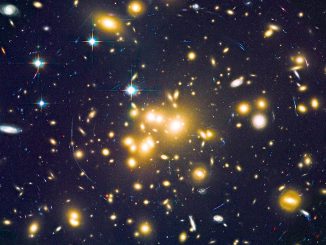
Extremely distant galaxies are usually too faint to be seen, even by the largest telescopes. But nature has a solution – gravitational lensing, predicted by Albert Einstein and observed many times by astronomers. Now, an international team of astronomers led by Harald Ebeling from the University of Hawaiʻi has discovered one of the most extreme instances of magnification by gravitational lensing.
Using the Hubble Space Telescope (HST) to survey a sample of huge clusters of galaxies, the team found a distant galaxy, eMACSJ1341-QG-1, that is magnified 30 times thanks to the distortion of space-time created by the massive galaxy cluster dubbed eMACSJ1341.9-2441.
The underlying physical effect of gravitational lensing was first confirmed during the solar eclipse of 1919, and can dramatically magnify images of distant celestial sources, provided a sufficiently massive object lies between the background source and us, the observers.
Galaxy clusters, enormous concentrations of dark matter and hot gas surrounding hundreds or thousands of individual galaxies, all bound by the force of gravity, are valued by astronomers as powerful “gravitational lenses”. By magnifying the galaxies situated behind them, massive clusters act as natural telescopes that allow scientists to study faint and distant sources that would otherwise be beyond the reach of even the most powerful man-made telescopes.
“The very high magnification of this image provides us with a rare opportunity to investigate the stellar populations of this distant object and, ultimately, to reconstruct its undistorted shape and properties”, states team member Johan Richard of the University of Lyon, who performed the lensing calculations.
Although similarly extreme magnifications have been observed before, the discovery sets a new record for the magnification of a rare “quiescent” background galaxy – one that, unlike our Milky Way, does not form new stars in giant clouds of cool gas.
Team leader Harald Ebeling explains, “We specialize in finding extremely massive clusters that act as natural telescopes and have already discovered many exciting cases of gravitational lensing. This discovery stands out though, as the huge magnification provided by eMACSJ1341 allows us to study in detail a very rare type of galaxy.”
Representing the endpoint of galaxy evolution, quiescent galaxies are common in the local Universe. “However, as we look at more distant galaxies, we are also looking back in time, so we are seeing objects that are younger and should not yet have used up their gas supply,” says Mikkel Stockmann, a team member from the University of Copenhagen. and an expert in galaxy evolution. “Understanding why this galaxy has already stopped forming stars may give us critical clues about the processes that govern how galaxies evolve.”
Follow-up observations of eMACSJ1341-QG1 are in progress, using telescopes in Chile and on Maunakea. Details of the discovery are published in the Astrophysical Journal Letters.



